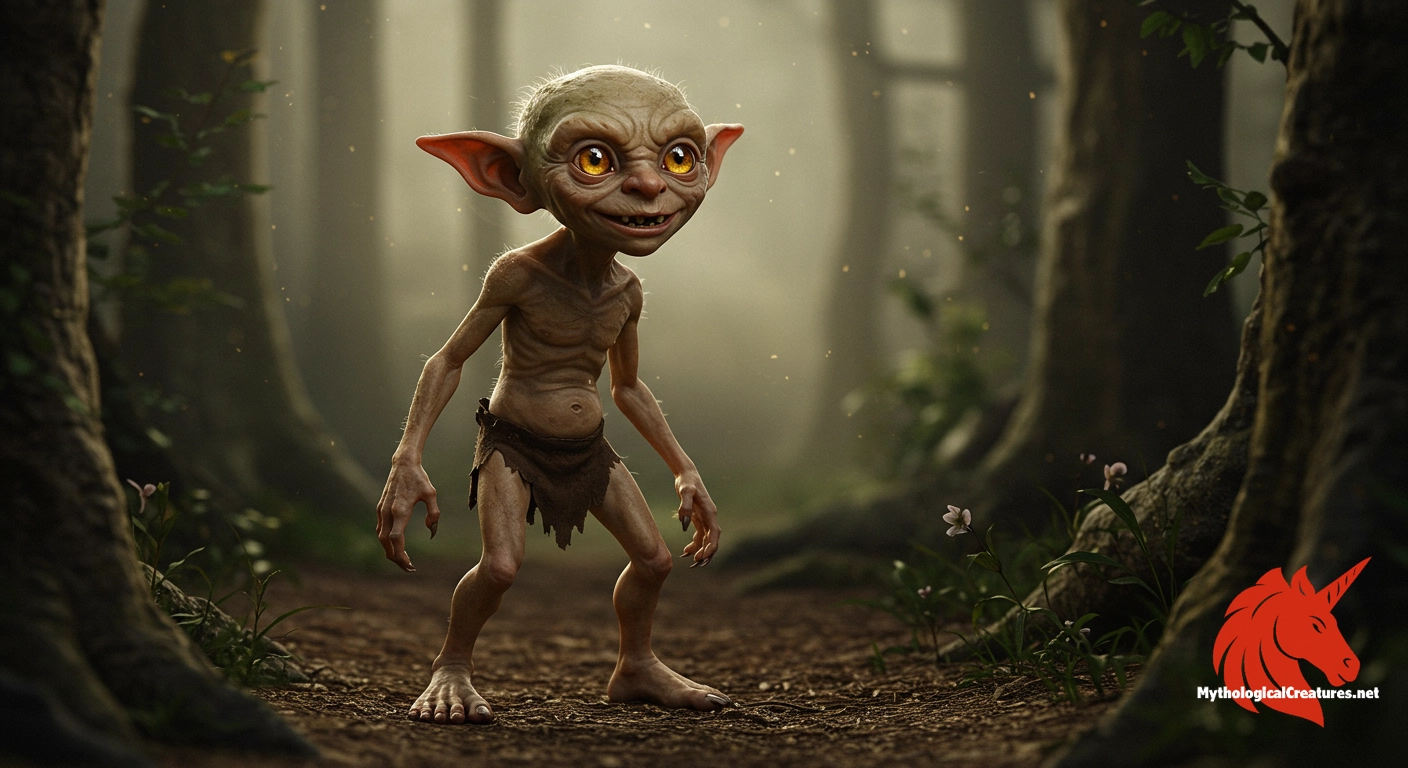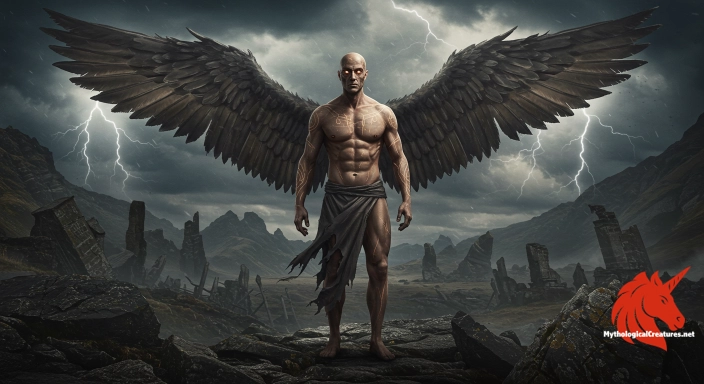Hobgoblin: The hobgoblin is a traditional English household spirit known for its dual nature of helpfulness and mischief.

Hobgoblin
Hobgoblin - Embodies the ambiguity of folk beliefs regarding domestic spirits, reflecting a shift from benevolence to playful trickery with Christian influence
Origins & First Encounters
The hobgoblin occupies a unique place in English folklore as a household spirit whose legacy intertwines benevolence with playful mischief. Born from the rich tapestry of rural traditions, this creature was initially seen as a helpful guardian of the home, endowing family life with a touch of the supernatural. Over time, however, as Christianity spread, its character evolved into one of capricious trickery and subtle malevolence. Its early appearances in folk narratives reveal a creature that both nurtured and tested the humans it encountered, reflecting the unpredictable nature of everyday life. The hobgoblin’s presence in literature and oral traditions marks it as one of the more memorable sprites of the British Isles. Its duality—being both aid and mischief-maker—resonated with communities facing the uncertainties of rural existence. Rich in local colour and moral subtext, the hobgoblin became a symbol for the balance between order and chaos within the domestic sphere. Many of these tales were passed down from generation to generation, each retelling adding layers to its mythic persona. Its legacy is immortalised in dramatic works and folklore collections, making it a beloved yet enigmatic inhabitant of legend. The tradition encapsulating the creature reflects a broader cultural dialogue on the nature of supernatural intervention in mundane life.
Source Texts & Tale Variants
The lore of the hobgoblin can be traced through an array of traditional texts and oral narratives that date back centuries. Early collections of English folklore preserved tales of these household sprites, describing them as both helpful figures and troublesome spirits. Notably, Shakespeare’s use of the character Puck in A Midsummer Night’s Dream offers one of the most celebrated literary attestations, casting the hobgoblin as a creature of caprice and wit. Folklorists of the 17th and 18th centuries would record similar anecdotes where hobgoblins secretly aided with domestic chores or contrived a bit of harmless mischief. Variants of the tales often diverged in tone; while some emphasised the creature’s beneficent aspects, others underscored its knack for trickery. Manuscripts and chapbooks from different periods provide snapshots of evolving attitudes toward such elusive spirits. Periodicals and local legends further enriched the characterisation of the hobgoblin, embedding it in the regional narratives of various communities. The assembly of these diverse sources has allowed modern readers to appreciate a creature whose many facets mirror the complex interplay of folklore and social change. Multiple story variants coexist, reflecting both regional colour and the inevitable reinterpretations as attitudes shift over time. This layered documentation ensures that the hobgoblin remains a vivid emblem of the mystique surrounding household spirits.
Form & Powers
Descriptions of the hobgoblin vary widely, yet a common theme is its diminutive, almost imperceptible form that belies its spirited nature. Many accounts detail a creature with a sprightly, nimble build, often depicted with angular features and an impish grin that hints at its mischievous character. Its eyes are commonly portrayed as twinkling with both wisdom and laughter, as if it harbours centuries of secret knowledge. Traditional illustrations, though rare, suggest a being with slightly exaggerated, pointy ears and a mane of hair that may spill over its brow in wild disarray. The attire of a hobgoblin is typically described as simple, reflecting the rustic origins of its legend, with garments that might appear slightly worn or patched from many years of service in the household. Some narratives hint at an ethereal quality, noting a faint glow or translucence that lends an otherworldly air. The creature’s size is often rendered as small enough to scurry unseen, yet its presence is unmistakably felt in the subtle rearrangement of domestic spaces. In various retellings, its appearance has been imbued with local flavour, ranging from a near-human quality to more fantastical traits resembling a woodland sprite. Intricate details such as a crooked smile, nimble fingers, and an agile posture all serve to reinforce its elusive nature. These physical descriptions, though not uniformly standardised, contribute to an enduring image that continues to capture the imagination.
Regional Faces
Regional interpretations of the hobgoblin demonstrate a fascinating adaptability that reflects local customs and beliefs. In many parts of rural England, it is envisioned as a resident spirit of the homestead, one whose temperament can swing from helpfulness to cunning trickery with little warning. In contrast, areas influenced by Celtic traditions often blend the hobgoblin’s image with that of other household sprites, creating a hybrid creature that shares traits with the brownie or even the Irish leprechaun. Northern regions sometimes imbue the character with a more earthy and rugged persona, portraying it as a steadfast, if enigmatic, protector of the home. Southern tales occasionally focus on its ability to both conceal and reveal hidden fortunes, weaving moral lessons into its antics. Local festivals and seasonal rituals have occasionally invoked the hobgoblin as both a benign force and a playful agent of chaos. There are communities where the lines between the hobgoblin and other minor faerie beings blur, resulting in overlapping narratives and a shared domestic mythology. This regional diversity underscores the adaptability of the hobgoblin myth, serving as a cultural mirror for the varied life experiences and superstitions across different locales. The creature’s guise is less fixed than that of more formal mythic entities, allowing it to evolve with the local zeitgeist. Its portrayal ultimately reflects the unique intersection of geography, tradition, and social character in each area.
Cultural Parallels
The hobgoblin stands alongside a rich pantheon of household spirits present in diverse cultural traditions, highlighting both universal themes and local intricacies. Among its closest counterparts is the Scottish brownie, renowned for its inadvertent aid in household tasks despite its secretive existence. In continental Europe, creatures such as the German kobold and the French lutin share the fairground of mischief and domestic presence that the hobgoblin occupies in English lore. Comparisons with Scandinavian beings like the tomte or nisse further underscore common threads of guardianship and trickery spanning across northern mythologies. Though each of these entities arises from distinct cultural soils, their roles often converge in the depiction of a spirit that blurs the line between benevolence and impish prankishness. Such parallels indicate a cross-cultural recognition of the need to personify unexpected events in daily life, offering both solace and an explanation for the inexplicable. Despite regional differences, the core idea of a small, capricious helper who can transform a mundane environment into a stage for subtle magic remains consistent. These similarities invite a broader contemplation of how human communities interact with the notion of supernatural aid in domestic realms. The hobgoblin, like its counterparts, serves as a reminder of cultural ingenuity in crafting figures that mirror humanity’s complex relationship with the unknown. Its enduring presence in the collective imagination highlights a shared human desire to understand, and sometimes control, the unpredictable nature of life.
Legacy & Modern Evolution
Over the centuries, the image of the hobgoblin has undergone significant transformation, mirroring broader cultural shifts and evolving social mores. Initially celebrated as an unseen guardian of the household, the creature gradually took on aspects of playful subversion and slight menace as narratives adapted to new religious and moral frameworks. In early modern England, the hobgoblin’s character became a vessel for both cautionary tales and light-hearted pranks, reflecting changing attitudes toward the supernatural. With the advent of modern media, this mythological being has been reimagined in literature, film, and graphic novels, often reflecting contemporary predilections for hybrid characters that mix mischief with empathy. Today, its legacy is frequently cited in fantasy role-playing games and popular culture, where it is portrayed as a charming trickster who embodies the unpredictability of magic. The evolution of its depiction from a purely domestic spirit to a multifaceted character mirrors the dynamic interplay between tradition and modern reinterpretation. Academic interest in folklore has also embraced the hobgoblin as a symbol of transitional belief systems and societal adaptation. While some modern retellings focus on its humorous side, others explore its deeper symbolic ties to the human condition and the balance of order and chaos. As communities continue to reinterpret folklore, the hobgoblin remains a vivid reminder of cultural resilience and the enduring allure of the supernatural. Its journey from folkloric obscurity to modern emblem attests to the power of myth to adapt to changing times and sensibilities.
Interesting Fact
An intriguing aspect of the hobgoblin is its evolution over time from a helpful domestic spirit into a celebrated trickster figure, reflecting broader cultural shifts in the interpretation of the supernatural.
Quick Creature Info
Features:
Associations:
Our Mythic Legendary Rating:

Also Sometimes Known As:
Habitat:
Supernatural Powers:
Physical Attributes:
Abilities:
Behavior:
Weaknesses:
Lore:
References
Discover Another Mythical Legend You May Not Have Heard Of?
Uncover the mysteries of ancient folklore and expand your knowledge of legendary beings from cultures around the world.
Dare to Meet the Ramiel....
Curated by the Mythological Creatures Team (rev. May 2025)
